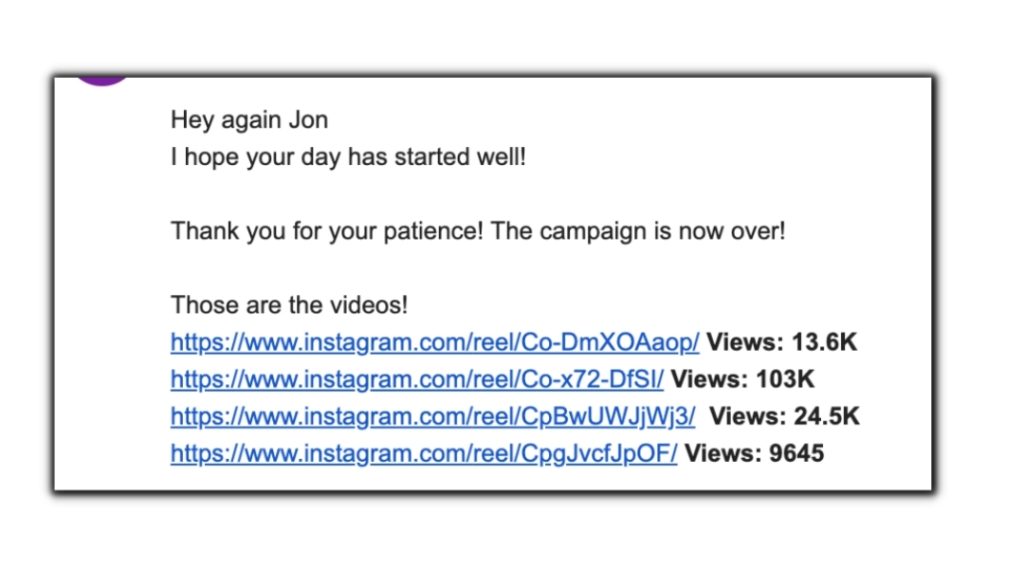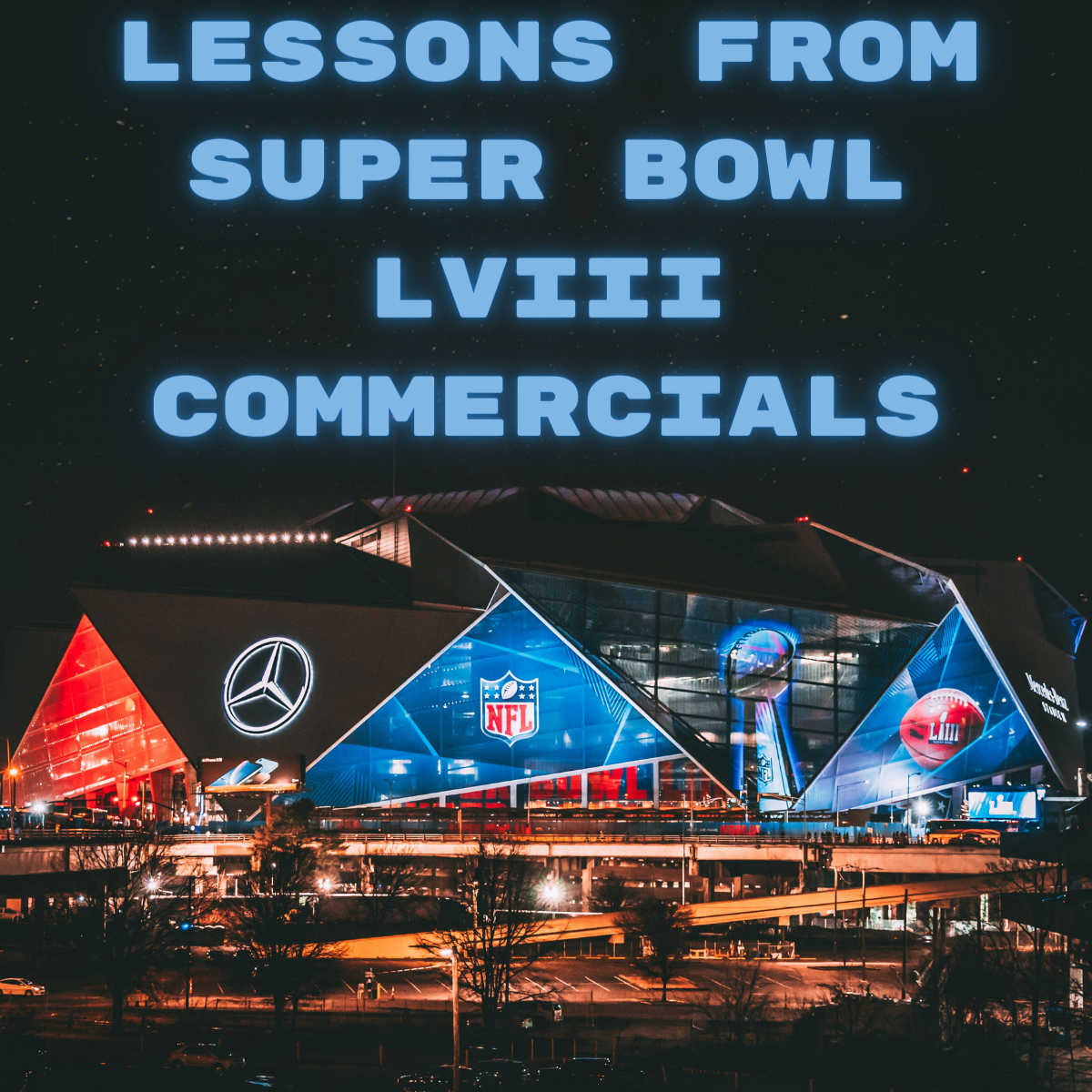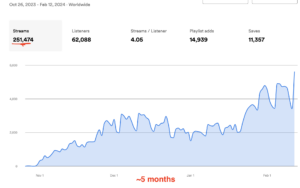I tried an Instagram influencer campaign last month.
If you’re not familiar with the concept, 1) good for you, and 2) here’s the gist: An “influencer campaign” basically means that you pay semi-famous social media users to make videos featuring your music.
There are two potential benefits to doing this:
- The influencer’s followers might see the post with your music and start to follow you.
- The post with your music might inspire other people to make posts with your music, too, causing a snowball of virality that ends up with you hosting Saturday Night Live and gracing the covers of Rolling Stone and Time and Better Homes and Gardens.
The second scenario isn’t particularly likely (read: it is virtually certain that it will not happen to you and Better Homes and Gardens has strict editorial standards).
But it’s the homerun shot, and a small flicker of hope in its occurrence is kept alive by the fact that every once in a while the impossible does happen: A song blows up on social media and the artist rockets to relevancy faster than you can say Lil Nas X.
Anyway, I wanted to give this tactic a shot, not because I had much expectation of its success, but because it’s an increasingly common offer from marketing agencies and I wanted firsthand experience with how it might work.
The campaign wrapped up this past week.
Here are the results the agency sent me:

Hey, not bad, right? I mean, that’s over 150,000 views right there – so like 100 times as many views as I’ve gotten on YouTube ever. I guess the song blew up!
Except, of course, that it didn’t.
There was no measurable impact on the song’s streaming stats. There was also no measurable impact on the artist’s social media platforms.
And here’s the thing: Every single one of those videos involves a random influencer doing a random activity in a way that is not at all related to the song that’s unobtrusively playing in the background.
Now, I’m not upset with the agency; they delivered exactly what they promised. Actually, they exceeded their target for video views, plus they were easy / enjoyable to work with.
But all of this leads me to my general opinion:
Influencer campaigns probably aren’t the best way to spend your money.
For two reasons:
1) Most social media influencers aren’t all that concerned with music.
Sure, they’ll have music (or at least some sound) playing in the background for whatever cool-looking short-form content they’re making – but rarely is the music a noteworthy component of a given video.
Obviously there are tons of exceptions to this. But…
2) Even when the music is a big part of the video, the data shows that organic content is much more likely to go viral.
I talked to Josh from ContraBrand last year when he was in the middle of compiling the agency’s stellar report on TikTok virality, which is definitely worth reading if you’re trying to grow on that platform.
(I’m not kidding. If you’re trying TikTok, read that report.)
They basically analyzed the 208 artists who “broke out” on TikTok in 2022 (you can read how they define that term), and their big finding was this:
Artists are most likely to “make it” by making their own content.
In fact, only 12 of 208 breakout artists on TikTok owed their success to paid influencer campaigns. The only promotional method with less success in driving virality? Paid ads (seven out of 208 artists).
Organic content just crushes paid content.
It makes sense. Paying to go viral has some weird undercurrent of inauthenticity, while most of the best and biggest trends have an intangible eccentricity – they’re weird in ways you wouldn’t expect, which is part of why it’s fun to be in on the joke.
Also, creators who are heavily active on a platform provide a line back to a person / personality. When the snowball starts spinning, there’s something at the center. If you’re just paying for promotion without an active presence, what will the views lead back to?
The answer is usually “nothing.”
And all of this is why I don’t think influencers campaigns tend to be the best marketing spend.
Now, as with all things, there are nuances and exceptions to this statement, and I think a few factors can make influencer campaigns more impactful:
- The song should be part of the video content (i.e., it’s not just playing in the background, it’s the context for the story)
- The song should speak to a common human emotion or experience but use a specific reference point (like a succinct story or metaphor)
- The person paying for the campaign should be on the platform themselves.
Certain platforms give you more input with influencers toward making this type of thing happen. Pearpop, for instance, allows you to issue a “Challenge” where you define exactly what you’d like influencers to make, then pay for the views as they come in. (It’s expensive.)
But yeah, if your chorus is “I miss you” and you pay four random influencers to put it underneath videos of their workout routines, you’re probably wasting your money.
On the other end of the spectrum, consider Cody Fry’s “I Hear a Symphony,” which went viral in 2021 before he even had a TikTok account, largely thanks to the way it perfectly soundtracked this video of an elderly couple dancing alone on a beach.
As difficult as it is to define, that’s the kind of thing that works.
But it’s like playing the lottery; it only pays off big once in a great while.
So that’s my take on influencer campaigns.
And wow, look at that – here I am wrapping things up and this is my shortest post in like three months.
Let’s keep it that way.
As always, here’s wishing you good luck.









